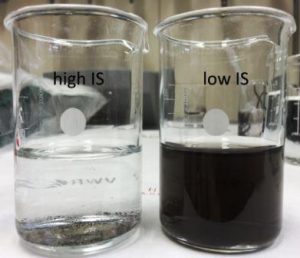In this post, Simon Lüderwald talks about their recently published paper “Palladium nanoparticles: is there a risk for aquatic ecosystems?”

Pd nanoparticle aggregation in medium with high (left) and low IS (right), indicating accelerated particle sedimentation with increasing IS (photo by S. Lüderwald)
Nano-sized palladium (nano-Pd) is used in catalytic converters of automobiles, from where it can be released into the environment by abrasion. Although these particles may subsequently be transported into surface water bodies, no data estimating their fate and toxicity in aquatic systems exists. By joining forces with colleagues from the Department of Chemistry and Biotechnology at the Swedish University of Agricultural Sciences we obtained first insights into the fate of nano-Pd (advertised size ~12 nm; hydrodynamic size ~70 nm) in aquatic environments with variable ionic strength (IS). These experiments supported our assumption of faster aggregation kinetics of nano-Pd with increasing IS. At the same time, no consistent effects of these nanoparticles on pelagic (Daphnia magna) and benthic species (Chironomus riparius) could be observed after 96 h of exposure. After 144 h of exposure, however, 50% of the daphnids were immobilized at a nano-Pd concentration in the low milligram per liter range.
When considering the relatively low environmental concentration of elemental Pd in surface waters (usually ng/L), though, this study suggests currently only a low acute risk for aquatic ecosystems. However, sublethal effects induced by nano-Pd as a result of chronic exposure should be assessed in future work to evaluate consequences over the long run. This seems of particular importance given the continuous use and thus emission of Pd from catalytic converters presumably resulting in a chronic exposure of organisms in surface waters at low concentrations.
The paper was authored by Simon Lüderwald, Frank Seitz, Gulaim A. Seisenbaeva, Vadim G. Kessler, Ralf Schulz and Mirco Bundschuh and is published in the Bulletin of Environmental Contamination and Toxicology.
